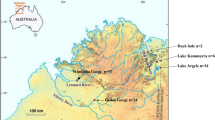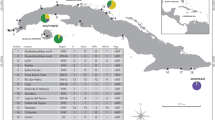Abstract
Conservation and management of widespread species can be improved if populations exhibiting genetic differentiation are recognized as local management units. Specimens of Nile crocodile (Crocodylus niloticus) corresponding to major river drainage systems from Eastern Africa and Madagascar, and a small set of samples from Western Africa, were analyzed using multilocus genotyping to evaluate the potential to discriminate among locations and to assign individuals to population of origin. Populations from all sampled regions exhibited marked levels of genetic and genotypic differentiation as assessed by significant F ST values and Bayesian analysis of population structure. At the regional level, the majority (94%) of all specimens were successfully assigned to the population of origin using only four microsatellite loci. Three populations sampled within Madagascar required the use of 12 loci for successful assignment of greater than 84%. Our findings demonstrate a need for alternative management strategies that consider the biogeographic sub-structuring of Nile crocodiles associated with major river drainages in Africa and Madagascar.


Similar content being viewed by others
References
Agnèse J (2003) Phylogeography of the African catfish, Chrysichthys maurus (Valenciennes, 1839). Afr J Aq Sci 28:327–337
Allendorf FW, England PR, Luikart G, Ritchie PA, Ryman N (2008) Genetic effects of harvest on wild animal populations. Trends Ecol Evol 23:327–337
Avise JC (1994) Molecular markers, natural history and evolution. Chapman and Hall, New York
Brown DM, Brenneman RA, Georgiadis NJ, Koepfli K, Pollinger JP, Mila B, Louis EL Jr, Grether GF, Jacobs DK, Wayne RK (2007) Extensive population genetic structure in the giraffe. BMC Biol 5:57
Ciofi C, Beaumont MA, Swingland IR, Bruford MW (1999) Genetic divergence and units for conservation in the Komodo dragon Varanus komodoensis. Proc R Soc Lond B 266:2269–2274
Comstock KE, Georgiadis N, Pecon-Slattery J, Roca AL, Ostrander EA, O’Brien SJ, Wasser SK (2002) Patterns of molecular genetic variation among African elephant populations. Mol Ecol 11:2489–2498
Comstock KE, Ostrander EA, Wasser SK (2003) Amplifying nuclear and mitochondrial DNA from African elephant ivory: a tool for monitoring the ivory trade. Cons Biol 17:1840–1843
deMenocal PB (2004) African climate change and faunal evolution during the Pliocene-Pleistocene. Earth Planet Sci Lett 220:3–24
Evanno G, Regnaut S, Goudet J (2005) Detecting the number of clusters of individuals using the software STRUCTURE: a simulation study. Mol Ecol 14:2611–2620
Excoffier L, Smouse P, Quattro J (1992) Analysis of molecular variance inferred from metric distances among DNA haplotypes: application to human mitochondrial DNA restriction data. Genetics 131:479–491
FitzSimmons N, Tanksley S, Forstner MR, Louis EE, Daglish R, Gratten J, Davis S (2001) Microsatellite markers for Crocodylus: new genetic tools for population genetics, mating system studies and forensics. In: Grigg G, Seebacher F, Franklin CE (eds) Crocodilian biology and evolution. Surrey Beatty & Sons, Chipping Norton, pp 51–57
Fraser DF, Bernatchez L (2001) Adaptive evolutionary conservation: towards a unified concept for defining conservation units. Mol Ecol 10:2741–2752
Fuchs K, Mertens R, Wermuth H (1974) Die Unterarten des Nilkrokodils, Crocodylus niloticus. Salamandra 10:107–114
Glenn TC, Staton JL, Vu A, Davis LM, Alvardo JR, Bremer P, Rhodes WH, Brisbin IL Jr, Sawyer RH (2002) Low mitochondrial DNA variation among American alligators and a novel non-coding region in crocodilians. J Exp Zool 394:312–324
Grandidier A (1872) Description de quelques reptiles nouveaux découverts a Madagascar en 1870. Annales des Sciences Naturelles (Zool et Biol Animal) 15:6–11
Guo SW, Thompson EA (1992) Performing the exact test of Hardy–Weinberg proportion for multiple alleles. Biometrics 48:361–372
Hekkala ER (2004) Conservation genetics at the species boundary: case studies from African and Caribbean crocodiles (Genus: Crocodylus). Doctoral Dissertation, Columbia University
Hutton JM (1987) Incubation temperatures, sex ratios and sex determination in a population of Nile crocodiles (Crocodylus niloticus). J Zool 211:143–155
Hutton JM (1989) Movements, home range, dispersal and the separation of size classes in Nile crocodiles. Amer Zool 29:1033–1049
Hutton JM (2000) Who knows best? Controversy over unilateral stricter domestic measures. In: Hutton JM, Dickson B (eds) Endangered species, threatened convention. The past, present and future of CITES. Earthscan, London, pp 57–66
King FW, Burke RL (1989) Crocodilian, tuatara, and turtle species of the world: a taxonomic and geographic reference. Association of Systematics Collections, Washington, DC
Mills LS (2007) Conservation of wildlife populations: demography, genetics, and management. Blackwell, Massachusetts, 407 pp
Moodley Y, Bruford MW (2007) Molecular biogeography: towards an integrated framework for conserving pan-African biodiversity. PLoS ONE 2:454
Moritz CM (1994) Defining “evolutionary significant units” for conservation. Trends Ecol Evol 9:373–375
Ogden JC (1978) Status and nesting biology of the American crocodile, Crocodylus acutus (Reptilia, Crocodilidae), in Florida. J Herpetol 12:183–196
Paetkau D, Calvert W, Stirling W, Strobeck W (1995) Microsatellite analysis of population structure in Canadian polar bears. Mol Ecol 4:347–354
Piry S, Alapetite A, Cornuet JM, Paetkau D, Baudouin L, Estoup A (2004) Geneclass2: a software for genetic assignment and first-generation migrant detection. J Hered 95:536–539
Poux C, Madsen O, Marquard E, Vieites D, de Jong W, Vences M (2005) Asynchronous colonization of Madagascar by the four endemic clades of primates, tenrecs, carnivores, and rodents as inferred from nuclear genes. Syst Biol 54:719–730
Pritchard JK, Stephens M, Donnelly P (2000) Inference of population structure using multilocus genotype data. Genetics 155:945–959
Ray DA, Dever JA, Platt SG, Rainwater TR, Finger AG, McMurry ST, Batzer MA, Barr B, Stafford PJ, McKnight J, Densmore LD (2004) Low levels of nucleotide diversity in Crocodylus moreletii and evidence of hybridization with C. acutus. Cons Gen 5:449–462
Raymond M, Rousset F (1995) GENEPOP (version 1.2): population genetics software for exact tests and ecumenicism. J Hered 86:248–249
Rodriguez D (2007) Crocodilian evolution, systematics and population genetics: recovery and ecological interactions of the American crocodile (Crocodylus acutus). Doctoral Dissertation, Texas Tech University
Ross JP (1998) Crocodiles status survey and conservation action plan. IUCN/SSC Crocodile Specialist Group. Available via http://www.flmnh.ufl.edu/herpetology/act-plan/plan1998a.htm. Accessed 1 Dec 2008
Schmidt KP (1919) Contributions to the herpetology of the Belgian Congo based on the collection of the American Congo Expedition, 1909–1915. Part I. Turtles, Crocodiles, Lizards, and Chameleons. Bull Am Mus Nat Hist 39:385–624
Schmidt A, Mausfeld P, Hekkala E, Shine T, Nickel H, Amato G, Bohme W (2003) Molecular evidence for species level divergence in West African Nile crocodiles Crocodylus niloticus (Laurenti, 1786). J Paleoevol 3:703–712
Schneider S, Roessli D, Excofier L (2000) Arlequin: a software for population genetics data analysis: Vers 2.000 genetics and biometry lab. Dept of Anthropology, Univ of Geneva, Geneva
Shine T, Bohme W, Nickel H, Theis DF, Wilms T (2001) Rediscovery of relict populations of the Nile crocodile Crocodylus niloticus in south-eastern Mauritania, with observations on their natural history. Oryx 36:260–262
Stankiewicz J, Thiart C, Masters JC, Wit MJ (2006) Did lemurs have sweepstake tickets? An exploration of Simpson’s model for the colonization of Madagascar by mammals. J Biogeo 33:221–235
Tattersall I (2006) Historical biogeography of the strepsirhine primates of Madagascar. Folia Primatol 77:477–487
Thorbjarnarson J, Messel H, King F, Ross J (1992) Crocodiles: an action plan for their conservation. International Union for Conservation of Nature and Natural Resources Crocodile Specialist Group. IUCN, Gland
Vrba ES (1995) The fossil record of African antelopes (Mammalia, Bovidae) in relation to human evolution and paleoclimate. In: Vrba ES, Denton GH, Partridge TC, Burckle LH (eds) Paleoclimate and evolution with emphasis on human origins. Yale University Press, New Haven, pp 385–424
Waser PM, Strobeck C (1998) Genetic signatures of interpopulation dispersal. Trends Ecol Evol 13:43–44
Yoder AD, Cartmill M, Ruvolo M, Smith K, Vilgalys R (1996) Ancient single origin of Malagasy primates. Proc Nat Acad Sci USA 93:5122–5126
Acknowledgments
This research was supported by the United States Environmental Protection Agency STAR Fellowship program, the American Museum of Natural History, and the Center for Environmental Research and Conservation (CERC) at Columbia University. We thank the Disney Conservation Fund and National Geographic Television for financial and logistical support for field work and sample collection in Madagascar. Additionally, we would like to thank Richard Ferguson for his crocodile wrangling expertise and for collecting the East African samples, Alison Leslie for South African samples, Tara Shine for Western Saharan samples and Gerardo Garcia for Ankarana cave samples. Thanks also to Nancy FitzSimmons and Jake Gratten for making available their unpublished microsatellite primers. Special thanks to the Blum Lab at Tulane University for comments on the manuscript and to Mark Siddall for field assistance and logistical support in Madagascar.
Author information
Authors and Affiliations
Corresponding author
Rights and permissions
About this article
Cite this article
Hekkala, E.R., Amato, G., DeSalle, R. et al. Molecular assessment of population differentiation and individual assignment potential of Nile crocodile (Crocodylus niloticus) populations. Conserv Genet 11, 1435–1443 (2010). https://doi.org/10.1007/s10592-009-9970-5
Received:
Accepted:
Published:
Issue Date:
DOI: https://doi.org/10.1007/s10592-009-9970-5




